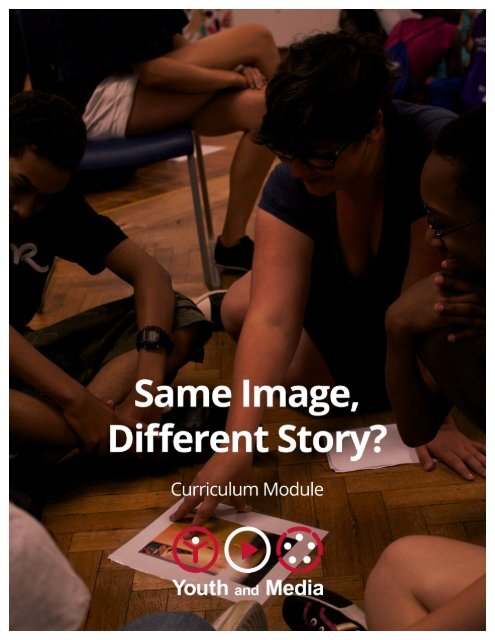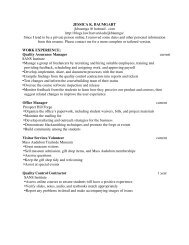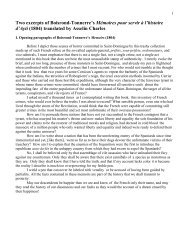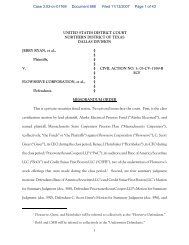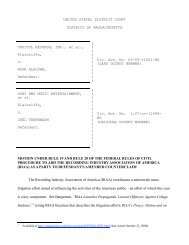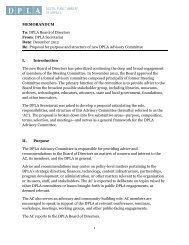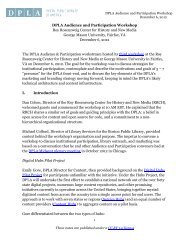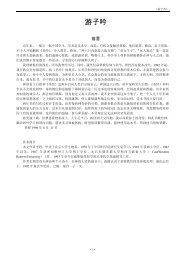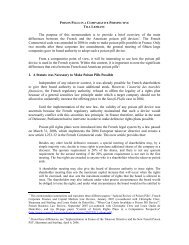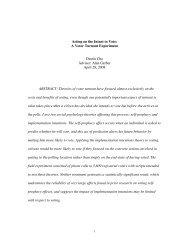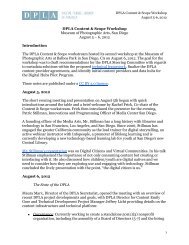Same Image, Different Story – PDF
Same Image, Different Story – PDF
Same Image, Different Story – PDF
You also want an ePaper? Increase the reach of your titles
YUMPU automatically turns print PDFs into web optimized ePapers that Google loves.
Overview<br />
Objectives<br />
Age/Grade<br />
Audience<br />
Duration<br />
Personnel<br />
Resources<br />
This activity familiarizes students with the numerous points of view from<br />
which any situation can be understood. Focusing on the particular case<br />
of the “Kissing Couple” during the Vancouver riots of 2011, students view<br />
and assess several videos, photos, and news articles in their<br />
explorations of the topic, and consider the importance of evaluating<br />
multiple sources and perspectives when developing an opinion of cases<br />
discussed online and in news media.<br />
• To understand how news stories can be told from different points of<br />
view by highlighting or omitting certain characters and facts.<br />
• To appreciate the importance of taking different points of view into<br />
account when trying to reconstruct or investigate an event.<br />
• To learn how to distinguish between the points of view in different<br />
sources of information and develop competencies with selecting and<br />
filtering sources for applied purposes.<br />
13 <strong>–</strong> 18 years old, Grades 8-12<br />
Entry level and up (no experience necessary)<br />
Approximately 80 minutes<br />
3 facilitators (can use 2 for each activity, for a total of 6).<br />
• Computer and projector<br />
• Whiteboard<br />
• 2x 3 cut-ups of the kissing couple photograph (2 of police, 2 of fans, 2 of<br />
kissing couple)<br />
• 2-3 videos of different types on the topic (news reports, raw footage on<br />
Youtube, etc.) (online, included in activity description)<br />
• 2 newspaper articles (printouts of article online, included in activity<br />
description)
Activity Description<br />
Activity One (25 minutes)<br />
What is Point of View?<br />
[Divide students into groups of three-to-five students;<br />
each group gets a different cut up of the photo to the<br />
left.<br />
Students are asked to tell a detailed story about<br />
what is happening in the picture. They can use pen<br />
and paper in order to create a short paragraph or a<br />
list of facts.<br />
[Ask: What is happening? Who is involved? Why?<br />
When? Where?]
[Students present their stories; Write down on blackboard/whiteboard the different answers and<br />
discuss briefly that there are different participants involved in the event. The protesters, the kissing<br />
couple, and the policy each have a specific view of what is happening.]<br />
The different understandings of the event are what we call “points of view.” How many<br />
different points of view did we just discuss?<br />
[Show the picture as a whole and contextualize the event, telling students that it happened after the<br />
final game of the Hockey Stanley Cup 2011 in Vancouver after the Boston Bruins beat the Vancouver<br />
Canucks. This pictures was taken by Richard Lam of Getty <strong>Image</strong>s while the riots were going on June<br />
15.]<br />
Questions about Point of View:<br />
• When you see the picture as a whole, do you get a more complete picture of what<br />
happened?<br />
• What do you think was going on?<br />
• What happened?<br />
• Why did the riots occur?<br />
Activity Two (20 minutes)<br />
Video Footage:<br />
Explain: Other media discussed this picture, too. They were intrigued by this image and were<br />
wondering the same thing as you are: Why was the couple making out in the street under these<br />
circumstances? This picture was shared on different social media networks internationally.<br />
<strong>Different</strong> people were trying to explain what was going on. Many different videos were shared<br />
on YouTube; lets take a closer look at some of them.<br />
The first video deals with the perspective of two reporters.<br />
http://www.youtube.com/watch?v=kX29Tt5d2ls<br />
[While looking at this video, please try to answer the following questions:]<br />
• What is happening in the photograph according to the news reporters?<br />
• Were the reporters close to the event when the photograph was taken?<br />
[Ask the students to provide descriptive terms that make up the news story’s coverage of the image.<br />
Note that the reporters approach the photograph in various ways: comical, artistic, amusing, and<br />
concerning.]<br />
• What is the narrative or story the reporters are telling?<br />
• How, or why, does the image get this type of a reaction from the reporters?
• What material did the reporters have to work with?<br />
• Were the reporters on location when it happened?<br />
This second video is taken from the point of view of an amateur videographer, a bystander<br />
who was standing on the top of a building.<br />
http://www.youtube.com/watch?v=30t3vhxSj9o<br />
[While looking at this video, please try to answer the following questions:]<br />
- Whose perspective is this (bystanders on a room)?<br />
- What is happening in the video?<br />
- How does the point of view of the amateur videographer change the story we<br />
talked about so far?<br />
- How would you describe the video in comparison to the one we just saw?<br />
- What is the story being told here?<br />
- Are there any other points of view that we have not yet talked about or taken into<br />
consideration?<br />
Activity Three (20 minutes)<br />
Newspaper Articles:<br />
Explain: We are now going to hand out two articles from different newspapers that also covered<br />
the event of the kissing couple during the riots.<br />
[Divide the students into their original groups of 3-5 and ask each group to do the following:]<br />
• Read and summarize articles (links below).<br />
• Try to find new points of view on the event.<br />
[Lead discussion, steering conversation towards these questions:]<br />
1) Guardian: “Vancouver kiss couple ‘were knocked down by riot police’.”<br />
http://www.guardian.co.uk/world/2011/jun/17/vancouver-kiss-couple-riot-police<br />
• After reading the article, did your opinion of the police change? If your opinion stayed<br />
the same, did the reasons for your opinion change after reading it?<br />
2) New York Times, The Lede (blog): “Overlooked Vancouver Video Shows ‘Kissing Couple’ Was<br />
Knocked Down by Riot Police”<br />
http://thelede.blogs.nytimes.com/2011/06/24/overlooked-vancouver-video-shows-kissingcouple-was-knocked-down-by-riot-police/<br />
• Discuss the statement: “In an e-mail to The Lede on Friday, Mr. Wing, a truck driver<br />
who calls himself ‘an aspiring photographer,’ added that, from his perspective, on a
parking garage just above the street, it looked like Ms. Thomas and Mr. Jones ‘were<br />
participants in the riot’ and ‘likely should have been arrested.”<br />
• How do you feel about the articles? Do you believe them?<br />
Closing Activity (15 minutes)<br />
[Lead discussion, steering conversation towards these questions:]<br />
• After seeing the full image, watching two videos, and reading two articles, do you have<br />
a more complete understanding of what was going on in Vancouver and in the streets<br />
during “the kiss?”<br />
• How do you understand the story so far?<br />
• Are there still other points of view that we have not talked about yet? (e.g. the kissing<br />
couple themselves, the hockey player, an injured person, people that live on the<br />
street, etc.)<br />
[Show video of kissing couple explaining what happened <strong>–</strong><br />
http://www.youtube.com/watch?v=tXtqtjot9-o]<br />
• How does this interview complement the other versions of the story we have<br />
reviewed?<br />
[Conclude the conversation by reinforcing the main points of the activity]<br />
Today we discovered that every event or story can be understood from multiple points of view.<br />
Depending on the point of view from which a story is told, different characters, details, and facts<br />
are included or omitted.<br />
• How many points of view did we discuss today? [Probe for: photographer, reporters,<br />
bystanders, police, and couple]<br />
• Why is it important to be aware of the different points of view? As you get different<br />
points of view on what happened, you get a more complete picture of the event.<br />
• Is it possible to obtain all the different points of view? Is it necessary? In real life, you do<br />
not always have enough time to gather all the different perspectives. Be cognizant of the<br />
risks associated with this.<br />
Take away message: Listening to and recognizing the multiple points of view present in an<br />
event can be beneficial for understanding and for contextualizing an event.<br />
• What is the advantage of having different versions of the story?


